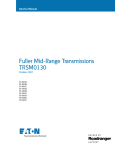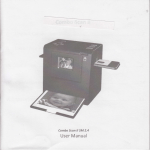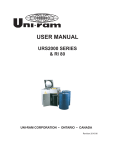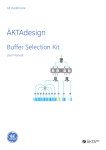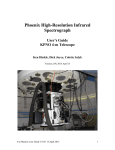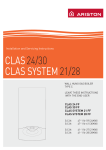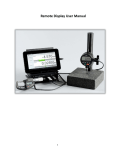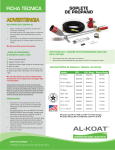Download ELECTRONIC Kawasaki FUEL INJECTION
Transcript
ELECTRONIC Kaw asa ki FUEL INJ ECT ION . ~- 'e TROUBLESHOOTING MA NU AL FOREWORD This manual covers the recommended troubleshooting procedures for Kawasaki Electronic Fuel Injection. It contains no disassembly and assembly, repair, or other maintenance information and is designed to be used in conjunction with the service manual covering the model being worked on. Remember that the operation of the Electronic Fue l Injection system is directly re lated to exhaust emissions and that the system must not be altered in any way. READ THE EMISSIONS INFORMATION ON THE FRONT OF THE SERVICE MANUAL FOR THE MODEL BEING WORKED ON! Before troub leshooting the Kawasaki Electronic Fuel Injection system, check the following , and replace, add, adjust, or repair if necessary. • • • • • There is sufficient fuel in the tank. Correct amount of specified engine oil is in the engine. Fuses are not blown out. The engine is cranked normal ly with the starter motor. Cylinder compression, spark plugs, valve clearance are norma l, and items other than fuelinjection-system related items are normal. NOTE : Measure the cylinder compression in the same way as for a carburetor model with the following exception. To stop fuel injector operation during the compression test, disconnect the white/red lead which connects the battery positive termina l to the fuel injection system harness under the left side cover. • • • • The oil filler cap, breather hose, and surge tank drain plug are installed correctly. All electrical connectors ar.e clean and tight. The ignition system is normal. There is no external damage. These are the special tools and instruments needed for troubleshooting the Kawasaki Electronic Fuel Injection system. ·-----These symbols appear in the text. @ / ·'O"::\ \_q )_; ((/ <.J °[ means ignition switch " OFF" means starter button is pushed means ignition switch " ON " means multimeter is connected as shown and switched to setting printed in meter symbol. --~:::::::: ~ 1LJ_l means clutch lever pulled (to activate starter switch) NOTE: For best results, start with TEST 1 and follow the instructions to the letter. This manual was designed to guide you through the Kawasaki Electronic Fuel Injection system in a careful and thorough examination of all its component parts. 3 ELECTRONIC FUEL INJECTIO N TROUBLE SHOOTIN G MANUAL All information contained in th is Supplement is based on the latest product information available at the time of publication. The right is reserved to make changes at any time without prior notice and without incurring an obligation to make such changes to products manufactured previously. Published by Product Serv ices, KMC. Copyright Kawasaki Motors Corp., USA 1980 Printed in USA First Issue: May 1 9 8 o 5 TEST 1 FUEL PUMP IN-CIRC UIT INSPEC TION • Turn ign ition switch " OFF" . • Disconnect the yellow/ red lead of the starter motor relay under the left side cover. This is to prevent the starter motor from working during this inspect io n. • Turn "ON" the ign ition switc h. • Push the starter button . • Pull in the clutch lever, and listen to the fuel pump. -) = START 0 ~ .-;,_ _..:-:::·:=:.:-'~ Pump runs Pump does not run Turn page to TEST 2. Go to TEST 18, page 41. 7 TES T2 START SIGNAL l NSPECT ION 1 • Turn off the ign ition switch, • ) sconnect the black and white 9-pin connectors from the re lay under the left side cover, and connect a voltmeter to the connector to check the start signaL ..___ _ _ _ _ _ _ __ _ _ _ _ _ __ __ g +--.Black ____,. Black/ Yellow 'O. ~=s-?? ...,...._ _ _- . . . J •• "" ~- Ll-J =>= STARY_ 7 to 10 volts Less than 7 or more than 10 volts Turn page to TEST 3. Inspect all leads and connectors and repeat TEST 2. 9 TEST 3 RELAY INSPECTION - :: save ti me, substitute a good relay for the suspected ::·oo em relay. If a good relay is not available, use TEST 23 page 50, to troubleshoot the suspect relay. 'vew relay does not cure problem New relay cures problems ~ep l ace original relay and turn Ja ge to TEST 4. Discard original relay. 11 TEST4 FUEL PUMP CONTACT IN SPECTION • 8emove the air cleaner element. • Pull off the right side cover. • Turn off the ignition switch, and disconnect the 7-p in conn ector from the air flow meter. Air Flow Meter Terminals Top • Connect an ohmmeter to the air flow meter term inals, as shown. Step 1 Push air flap Step 2 Release air flap RX10 RX10 ohms ohms ohms Rep lace the air flow meter Turn page to TEST 5 Go to Step 2 RX10 ohms Rep lace the air flow meter 13 TESTS IGNITION SIGNAL INSPECTION Ii • =:~ov e the fuel tank. • - _·r off the ignition switch. • J sconn ect the Electronic Control Unit. s-==> ~ 1 COILS -~~ • :..ttach a voltmeter to the green coil primary lead, and ~~en to the black. • - urn on the ignition and activate the starter. /---~" C::)~ART j l.Aeter shows battery voltage and ' cJcers regularly on both wires _ M eter shows zero volts on one or both wires Troub leshoot Ignition System according to the Service Manual. TOIC IGNITER ~:-- 74 TO FRAME BLACK /~""'\\ . . . \ lY.) '"""s_T_E_P_2_: -~f------------• Attach a voltmeter to the green wire and then the black in the ECU connector. • Turn on the ignition and activate the starter. (~ ~~ ~ =>~ ~ Meter shows battery voltage and flickers regularly on both wires. Meter shows zero volts on one or both wires. Turn page to TEST 6. Check the wiring to the IC Igniter from the ECU and troubleshoot the Ignition System accord ing to the Serv ice Manual. 5a:------. ;A. TO FRAME 15 FU EL INJEC TOR SOUN D IN SPECT ION TES T& • Start the engine. • ;::>ace the ti p of a screwd river aga in st one of the injec:ors. Put your ear on the gri p end and li sten to c heck ..vhether the injector is c lick in g or not. • Do th e same for the other injectors. Sound Inspection 1. Fuel Injector 2. Screw Driver Injectors click reg ularly One or more injectors does not click regularly Turn page to TEST 7. Go to TEST 20, page 45. NOTE : 1. The interval between cl icking sounds becomes shorter as the engine speed rises. 2. If the engine does not start, perform this inspection while cranking the eng ine with the starter motor. 17 TEST 7 FUEL PRESSURE IN SPECTION • Pull the right side cover off, and disconnect the highpressure fuel hose from the fuel pump outlet. I...._WARNING I When the fuel hose is pulled off, a small _____ amount of fuel may spout out because of residual pressure in the fuel line. Cover the hose connection with a clean cloth to prevent the fuel from flying about. • In stall the pressure gauge (special tool) between the fuel pump and the hose disconnected using the adapter (spec ial too l) and high-pressure fuel hose. • Tighten the hose clamps in the correct position . PRESSURE GAUGE- ___ AVERAGE READING --..._ PRESSURE GAUGE P/ N 57001-1089 • Install the fuel tank. PUMP TO INJECTORS WARNING I Do not attempt to start the engine while I..,._ _ _ _.. !the fuel hoses are disconnected. • Start the engine, and read the gauge. Engine idling, gauge reads 2.2 to 2.4 kg/cm2 (31 to 34 psi) The moment the throttle is fully opened, the gauge reads 2.4 to 2.6 kglcm2 (34 to 37 psi) If engine will not start, remove air cleaner and push air fl ap. Pressure gauge reads 2.4 to 2.6 kg/cm2 (34 to 3 7 psi) Turn page to TEST 8. Go to TEST 21 , page 4 7. 19 FUEL SYSTEM LEAK INSPECTION TESTS Inspect the connections between the parts shown below for leaks. ~ 6 6 ~ No leaks Leaks Turn page to TEST 9. Repair leaks. NOTE: Use genuine Kawasaki parts or equivalent. 21 FUEL FILTER INSPEC TION AND FUEL SYSTEM CLEANI NG TES T9 1 . Clean the fuel system in a well- ventilated area, and take ample care there are no spa rks or flame anywhere near the working area. ~ - Never clean out the fuel system when the engine is still warm . 3 . Wipe any fuel off the engine before starting it. AR NING 1 ~soect the fuel filter for proper insta llation, water, debris, a -id damage. No water, debris, or damage. Pro::>erly in stalled. Water or debris in filter or filter da maged. ~ urn • Remove the fuel tank and drain it. • Remove the fuel tap from the tank, and clean the fuel tap filter with a high flash-point solvent. • Flush out the fuel tank with a high flash-point solvent. • Clear the air vent in the tank cap with compressed air. • Remove the fuel pump, fuel injectors, fuel distributing pipe, and pressure regulator; and c lean them using a high flashpoint solvent. • Rep lac e the fue l filter and hoses with new ones. • Install the parts on the motorcycle. Use new hose c lamps. page to TEST 10. Fuel Filter Installation (1) Good Top From Tank Q NI (2) Wrong To Fue l<:> Pump } Air III [I .lnO To Fuel Pu mp Q From Tank c) 23 AIR FLOW METER FLAP INSPECTION TES·T 10 • Remove the air flow meter. • Check the air flamp movement by pushing it from the air cleaner side. Flap swi ngs smoothly wi thou t binding, returns to res t position by itself. Flap does not move smoothly, or does not return to the closed position by itself. Turn page to TEST 11. Rep lace Air Flow Meter. 25 TEST .11 AIR FLOW METER POTENTIOMETER INSPECTION • Turn off the ignition switch. • Disconnect the 7-pin connector from the air flow meter. STEP 1. Make the connections shown at right. D RX100 STEP 1 ohms Air Flow Meter Terminals c:::J CJ c:::J #39 #36 #7 - D #27 . - --- ____) Bottom 350 to 4000 Less than 350 or more than 4000 Replace air flow meter. Top c:::J c:::J D c:::J #39 # 36 #6 #9 Bottom STEP 2 Air Flow Meter Terminals D STEP 2. Make the connections shown at right. RX100 ohms n Any values other than 0 or n with flap in any position. O or Turn page to TEST 12. Replace air flow meter. oo flap in any position. oo 27 TEST12 AIR TEMPERATURE SENSOR INSPECTION ~ 10,~, y~? / -=--:\ • Turn off the ignition switch, and disconnect the 7-pin connector from the air flow meter. • Connect an ohmeter to the air flow meter terminals as shown at right. ~.F___;?, _../: \: 2.1 to 2.9 KOat 2o·c (72°F) Less than 2.1 or greater than 2.9 KOat 2o·c (72°F) Turn page to TEST 13. Replace the Air Flow Meter. D RX1K ohms Air Flow Meter Terminals Top CJ CJ #39 #36 #6 #9 CJ CJ #8 #7 #27 J Bottom 29 ENGINETEMPERATURESENSOR INSPECTION TEST 1 3 • =iemove the fuel tank. • - urn off the ignition switch, and disconnect the lead of ~'le engine temperature sensor. • Measure the resistance of the sensor w ith an ohmeter. Make the connections as shown at right. D RX1K >--+ ohms ,__ - -2.1 to 2.9 Kn at 20°C (72°F) Less than 2.1 or more than 2.9 Kn, at 20°C (72°F) Tu rn page to TEST 14. Replace Engine Temperature Sensor. 31 TEST1 4 THROTTLE VALVE SWITCH INSPECTION • Turn off the ignition switch, and disconnect the 3-pin co nnector from the throttle va lve switch. mr .·- · ·--·" Throttle Valve Switch Terminals / I • Connect an ohmeter to th e throttle va lve switch as shown at right. STEP 1 D STEP 1 Make connections show n at righ t. Move throttle. RX100 + ohms Throttle Released = 0 S1 Throttle Released = greater than Throttle fully open Throttle fully open = ooS1 Go to STEP 2. on = less than ooS1 Rep lace Throttle Valve Sw itch . STEP 2. Make connections shown at right. Move throttle. Throttle released = ooQ Throttle fully open = 0 n Throttle released = less than oo.Q Throttle fully open = greater than on STEP 2 D RX100 ~ + ohms ~ Turn page to TEST 15. Replabe Throttle Valve Switch. 33 TEST15 HARNESS INSPECTION If each component checks out good upon individual inspection, but the system does not work well when they are connected together, inspect the harness for the Electron ic Fuel Injection system as follows : • Remove the harness. • Make sure all connectors are clean and tight. • Examine wires for signs of burning, fraying, etc . • Check conductivity of the wires in the harness. Both ends of the same color wire should conduct. • Check the 0-ring in the multi -pin connectors for damage, and check the retaining clip of the connector for deformation. ' "- - ····' Harness is in good condition. Harness is in poor condition. Turn page to TEST 16. Replace the Fuel Injection Wiring Harness. 35 THROTTLE VALVES LINK MECHANISM INSPECTION TEST16 • Check the throttle valve and the fast idle link mechanism for smooth operation. Throttle valves and fast idle mechanism work smoothly. Throttle valves or link mechanism bind, or do not operate properly. Turn page to TEST 17. Replace the problem parts and go to TEST 22, page 37 TEST1 7 AIR LEAK INSPECTION • Inspect the connections between the parts shown for air leaks. No air leaks. Air leaks Replace Control Unit Replace problem parts Air Leak Inspection 1. Air Cleaner Element 2. Rubber Fitting 3. Air Flow Meter 4. Rubber Seal 5. Surge Tank 6. Ait Ducts 7. 3-Way Joint 8. Pressure Regulator 9. Vacuum Hoses 10. Rubber Caps (on hose fittings) 11 . Fuel Injectors 1 2. Cylinder Head 13. Throttle Valve Holders 14. Throttle Valves 1 5. Breather Hose 16. Air Cleaner Housing 1 7. Drain Plug 1 8. Breather Cover 19. Oil Filler Cap 20. Oil Seal (on crankshaft right end) 21. Others (mating surfaces, etc.) 39 [ OUT-OF -CIRCUI T FUEL PUMP INSPEC TION TES T18 • Disconnect the 2-pin connector of the fuel pump under the left side cover. • Connect a 1 2-volt battery to the 2-pin connector (pump side), and check whether the pump operates. Pump runs Pump does not run Turn page to TEST 19 Check pump leads and replace problem parts. Repeat TEST 18. + 12V 41 TEST1 9 FUEL PUMP CIRCUIT INSPECTION • Remove the air cleaner element. • Connect a voltmeter to the 2-p in connector (harness side), as shown at right. Black/Yellow Orange/ Black To Harness Fuel Pump Connector STEP 1 • Ignition switch "ON". • Starter Button "Pushed". • Clutch lever " Pulled". Battery voltage (12 to 14 volts) ,,...- ....... - ) ::..= START No battery voltage Go to TEST 2, page 9, and TEST 3, page 11 . STEP 2 • Ignition Switch " ON" . • Air Flow Meter Flap " Pushed". Battery voltage (12 to 14 volts) No battery voltage Go to TEST 2, page 9. Go to TEST 4, page 13, and TEST 3, page 11 . 43 FUEL INJECTER SIGNAL INSPECTION TEST20 I WARNING I the Do not attempt to start the engine while fuel hoses are disconnected. fuel will spout from the fuel line if you attempt to start the engine with the fuel hoses disconnected. • Remove the fuel tank and disconnect all of the 2-pin connectors from all the injectors. Yellow Red/ White To Harness Injector Connector @~!IoIJ ;:r~ ~~~e:~~~!~~:~ i~i:~~t~;~~ ~~;nb~~: tery positive(+) terminal even when the ignition siwtch is off, so take care not to short the test leads to the chassis ground. • Crank the engine with the starter motor and watch meter needle. . :~ -~-~;:·:::·::,3·..--,:F .·----- Meter needle flickers at regular intervals. Meter needle does not flicker at regular intervals. Rep lace injector. Check wiring and connectors. - '--1 - REPEAT TEST FOR ALL INJECTORS ! 45 TE ST 21 PRESSURE REGULATOR INSPECTION Pressure too high - start here. • Check the fuel return li ne for obstructi ons. • Check the vacuum hose for air leaks. Fuel Return Line Fuel Return Line open and no air leaks Fuel Return Line clogged or Vacuum Hose leaking Rep lace pressure Regu lator and go back to TEST 7, page 19. Rep lace bad parts and go back to TEST 7, page 19. Reg ula to· Vacuum Hose ;--------·Tank ·······\ '! - Regu lator ~ i l ~ ~ Pressure too low - start here. r Check for ~ ~ obs.t ructions ,._~__...i~v--A- ..., fj"""~1 P ump ~ ,T ,) "--. ~ ) ~ Filter Check tor leaks ~ ~ =----=="--'.~ l~ors ~ ~ • Check fuel hose from fuel tap to pump in let for obstructi ons. • Check high pressure fuel lines for leaks. 46 rr '~ No leaks or obstructi ons Leaks or obstructi ons Go to top of page 47. Replace problem parts and go back to TEST 7, page 19. Pressure too low - continued. • Plug or clamp return line to fuel tank and repeat TEST 7. Pressure okay or too high Pressure too low Replace regulator Rep lace fu el pump 47 THROTTLE VALVE SYNCHRON IZATION INSPECTION TEST2 2 If one of the throttle va lves is replaced, or if combustion varies from cy linder to cylinder, synchron ize the throttle valves. NOTE: These procedures are explained on the assumption that the intake and exhaust systems of the eng ine are in good condition. Checking engine vacuum : • Warm up the engine thoroughly. • Remove the fuel tank and put it on the work bench near the motorcycle on the same level as the original position. • Pull off the two vacuum hoses for the pressure regulator and the two rubber caps from the fittings on the throttle valves. • Attach the vacuum gauge (special tool) to the fittings. • Using suitable hoses, connect the fuel tap to the fuel filter, and the check valve to the pressure regulator. • Start the engine, and let it idle. • Adjust the idle speed. • Note the gauge readings. 48 All cylinders are within 3 cm Hg of each other. One or more cylinders are more than 3 cm Hg away from the others. Throttles are synchronized. Synchronize throttles, page 49. TH ROTTLE VALVE SYNCHRONIZATION PROCEDURE • Stop the eng ine. • To change the vacuum , open the throttle, loosen the locknut, and turn the balance adjusting screw. NOTE: 1. Loosen the locknut with the throttle valves opened. NOTE: 2. First synchronize the left two or right t~ cylinders by means of the adjusting screw 1 or between No. 1 and No. 2 cyli nders, or o. 3 and No. 4 cylinders. Then synchronize the left two cylinders and the right two cylinders using the center adjusting screw @. Adjust the idle speed as necessary. • Tighten the locknuts. • Open and close the throttle a few times to make sure that the throttle valves are synchronized. Readjust if necessary. • Install all parts previously removed, and adjust the idle speed. ® Adjusting Screw for Synchronization 1. Left Adjusting Screw : Turn this screw clockwise to lower No. 1 cy linder vacuu m. 3. Center Adjusting Screw : Turn th is screw clockw ise to lower No. 1 and No.2 cyl in der vacuu m sim ultaneously. 2. Right Adjusting Screw : Turn this screw clockw i se to lowe r No. 4 cyli nder vacu um. 49 TEST 23 RELAY INSPECTION The re lay is divided into two parts: the main re lay and the fue l pu mp relay. The two parts are tested in eight separate steps. Before starting the in spection procedure, prepare a twelve vol t battery with aux iliary leads, and remove the relay. + 12V STEP 1 Make the con nections show n at rig ht. Meter shows continui ty Meter shows no continuity Go to STEP 2. Replace relay STEP 2 Make th e connection s shown at right. 50 Meter shows no continuity Meter shows continuity Go to STEP 3. Rep lace relay + 12V STEP 6 Make the connections shown at right. Meter shows no continuity Meter shows continuity Go to STEP 7 Replace relay I ~ ~ STEP 7 Make the connections shown at right. Meter shows continuity Meter shows no continuity Go to STEP 8. Replace relay 12V 3.4W Light Bulb + r J 12V 8'. 1. STEP 8 Make the connection shown at right. 52 --J ~ ~o ;)$ _ [~ s~ , I ~' ~' ~ -==::\___~ 8 •111-"J.. Co11 e..::o~ Si~~ Bot:l)'fl' Meter shows no continuity Meter shows continuity Relay is okay. Check all connections and wiring. Replace relay






























